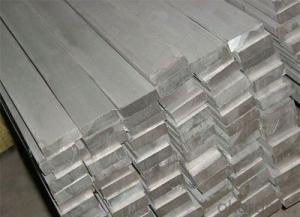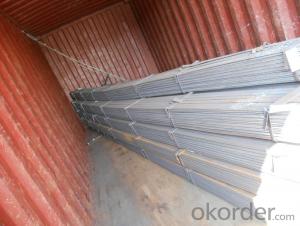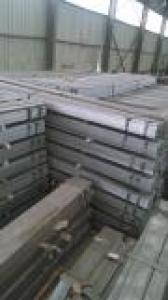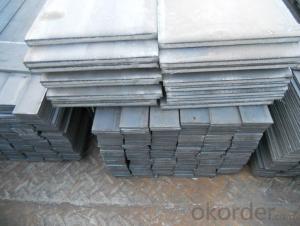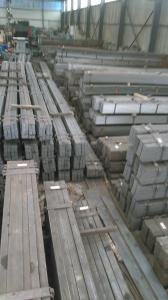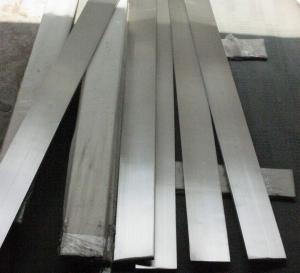Flat Bar Iron Steel Slitted
- Loading Port:
- China Main Port
- Payment Terms:
- TT or LC
- Min Order Qty:
- 100 m.t.
- Supply Capability:
- 10000 m.t./month
OKorder Service Pledge
OKorder Financial Service
You Might Also Like
OKorder is offering Flat Bar Iron Steel Slitted at great prices with worldwide shipping. Our supplier is a world-class manufacturer of steel, with our products utilized the world over. OKorder annually supplies products to African, South American and Asian markets. We provide quotations within 24 hours of receiving an inquiry and guarantee competitive prices.
Product Applications:
Flat Bar Iron Steel Slitted are ideal for structural applications and are widely used in the construction of buildings and bridges, and the manufacturing, petrochemical, and transportation industries.
Product Advantages:
OKorder's Flat Bar Iron Steel Slitted are durable, strong, and wide variety of sizes.
Main Product Features:
· Premium quality
· Prompt delivery & seaworthy packing (30 days after receiving deposit)
· Can be recycled and reused
· Mill test certification
· Professional Service
· Competitive pricing
Product Specifications:
Commodity: Mild Steel Flat Bar
Standard: GB;JIS
Material: Q195-235;SS400
Origin place: China
Thickness: 3mm-30mm
Width:20mm-200mm
Length: Max 12m
Certification: SGS/BV
Packaging: Export packing, nude packing, bundled
Alloy No | Grade | Element(%) | ||||
C
| Mn
| S
| P
| Si
| ||
Q235
|
B
|
0.12—0.20 |
0.3—0.7 |
≤0.045 |
≤0.045
|
≤0.3
|
Alloy No | Grade | Yielding strength point(Mpa) | Tensile strength (Mpa) | Elongation after fracture(%) | ||||||
Thickness (mm) | Thickness (mm) | |||||||||
≤16 | >16--40 | >40--60 | >60--100 | ≤16 | >16--40 | >40--60 | >60--100 | |||
≥ | ≥ | |||||||||
Q235 |
B |
235 |
225 |
215 |
205 |
375--500 |
26 |
25 |
24 |
23 |
FAQ:
Q1: Why buy Materials & Equipment from OKorder.com?
A1: All products offered byOKorder.com are carefully selected from China's most reliable manufacturing enterprises. Through its ISO certifications, OKorder.com adheres to the highest standards and a commitment to supply chain safety and customer satisfaction.
Q2: How do we guarantee the quality of our products?
A2: We have established an advanced quality management system which conducts strict quality tests at every step, from raw materials to the final product. At the same time, we provide extensive follow-up service assurances as required.
Q3: How soon can we receive the product after purchase?
A3: Within three days of placing an order, we will arrange production. The normal sizes with the normal grade can be produced within one month. The specific shipping date is dependent upon international and government factors, the delivery to international main port about 45-60days.
Images:
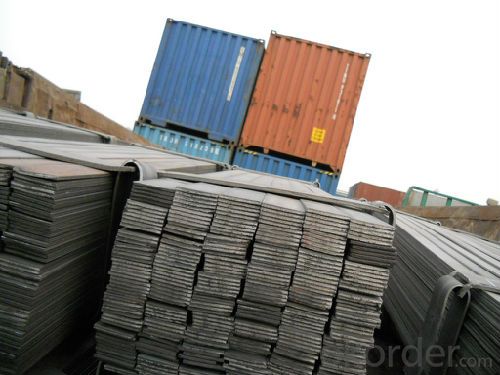

- Q:Can steel flat bars be polished?
- Certainly, it is possible to polish steel flat bars. The act of polishing these bars entails the utilization of abrasive elements like sandpaper or polishing compounds to eliminate any flaws or coarseness present on the surface. Typically, this procedure involves gradually progressing through various grades of sandpaper or utilizing a polishing wheel with a polishing compound in order to achieve a smooth and glossy result. By polishing steel flat bars, their visual appeal can be enhanced, rendering them more aesthetically pleasing.
- Q:What are the common methods of surface treatment for steel flat bars?
- Steel flat bars in various industries commonly undergo several surface treatment methods to enhance their properties, improve their appearance, and safeguard against corrosion. 1. Hot-dip galvanizing: Among the most widely employed methods is hot-dip galvanizing. This involves immersing the steel flat bars into molten zinc, forming a protective coating on the steel's surface. This coating offers exceptional resistance to corrosion and durability. 2. Powder coating: Another popular approach is powder coating, where a fine powder is electrostatically applied to the steel flat bars. The coated bars are then heated, fusing the powder into a smooth and long-lasting coating. Noteworthy benefits of powder coating include a broad range of color options, excellent corrosion resistance, and a uniform appearance. 3. Electroplating: Electroplating entails depositing a thin layer of metal, such as zinc, nickel, or chrome, onto the steel flat bars using an electric current. This method provides a decorative finish, enhances corrosion resistance, and improves wear resistance. 4. Passivation: To remove surface contaminants and establish a passive oxide layer, passivation involves a chemical treatment. This layer effectively enhances the steel's corrosion resistance by preventing rust formation. Passivation is commonly combined with other surface treatments to maximize their effectiveness. 5. Painting: Painting is a widely utilized surface treatment method for steel flat bars. It involves applying paint or a specialized coating to safeguard against corrosion and enhance appearance. Depending on specific requirements, different types of paints, such as epoxy, polyurethane, or enamel, may be used. In summary, these common surface treatment methods for steel flat bars offer numerous advantages, including corrosion resistance, improved appearance, and increased durability. The selection of the appropriate method depends on factors such as the intended application, budget, and desired surface finish.
- Q:Where can I buy ground level bending machine?
- When lap welding is adopted, the welding length is as follows: 1. Galvanized steel bar is not less than 2 times its width, no less than three surface welding. When the width of flat steel is different, the length of lap should be wide. Before laying, the flat steel should be adjusted straight, simmer, bend not to die, straight line should not be obvious bending, and should stand upright. 2. The length of galvanized round steel shall be no less than 6 times of its diameter, and shall be welded on both sides (when the diameter is different, the lap length shall be of big diameter).
- Q:What is the difference between a steel flat bar and a steel round bar?
- The shape and structural characteristics are what differentiate a steel flat bar from a steel round bar. A steel flat bar has a flat and rectangular cross-section, making it strong and stable. Its flat shape allows for easy attachment to other materials or surfaces, which is why it is commonly used in construction for framing, braces, and supports. On the other hand, a steel round bar has a circular cross-section and is widely used in engineering, manufacturing, and construction. Its round shape provides excellent strength and flexibility, making it suitable for applications that involve bending, twisting, or shaping. It is commonly used as a shaft, dowel pin, or as a component in machinery, equipment, or structural frameworks. When it comes to manufacturing, steel flat bars are typically produced through hot rolling or cold drawing processes. This results in a flat and smooth surface. Conversely, steel round bars are usually manufactured through hot rolling or machining processes, which shape the steel into a round cross-section. To summarize, the primary differences between a steel flat bar and a steel round bar lie in their shape, structural characteristics, and intended applications. The flat bar is ideal for providing stability and strength in construction projects, while the round bar offers flexibility and versatility in various engineering and manufacturing applications.
- Q:Connect the equipotential terminal box to the ground flat iron. Can I use plain flat steel?
- Specification requirement is 25*4 or 40*4 hot galvanized flat steel, said the family specification is also very reasonable, even galvanized flat steel, long time buried in the soil or on the floor, the wall will be laying, easy to rust, if we use the normal flat iron, not to mention that, certainly rust, but the speed is much faster than galvanized flat steel!
- Q:How do you straighten a bent steel flat bar?
- To straighten a bent steel flat bar, you can use a few methods. One common approach is to apply heat to the bent area using a torch until it turns red-hot and then use a vice or a sturdy surface to gradually bend it back into shape while it cools down. Another method involves using a hydraulic or mechanical press to apply controlled force to the bent area until it straightens out. It's important to note that the exact method may vary depending on the thickness and type of steel used, so consulting with a professional or referring to specific guidelines is recommended.
- Q:Can steel flat bars be used for making brackets or supports for audio/video equipment?
- Yes, steel flat bars can be used for making brackets or supports for audio/video equipment. Steel is a durable and strong material, making it suitable for supporting heavy equipment. The flat shape of the bars allows for easy attachment to walls, ceilings, or other surfaces. Additionally, steel flat bars can be easily cut and shaped to fit the specific dimensions and requirements of the equipment. They provide stability and can withstand the weight and stress of audio/video equipment, ensuring safe and secure mounting.
- Q:How do steel flat bars perform in high-vibration environments?
- Steel flat bars are known for their exceptional strength and durability, making them suitable for a wide range of applications. However, when it comes to high-vibration environments, their performance can be affected. In high-vibration environments, steel flat bars are prone to fatigue failure due to the repeated stress cycles caused by the vibrations. This can lead to cracking or even complete failure of the bars over time. To mitigate these issues, there are several measures that can be taken. The first is to select a steel alloy that has high resistance to fatigue and can withstand the vibration levels expected in the environment. Additionally, the design of the structure or system should take into account the potential for vibrations, ensuring that the flat bars are properly supported and reinforced to minimize stress concentrations. Furthermore, proper installation and maintenance are crucial to ensuring the performance of steel flat bars in high-vibration environments. Regular inspections should be conducted to identify any signs of fatigue or damage, and necessary repairs or replacements should be carried out promptly. In summary, while steel flat bars offer excellent strength and durability, their performance in high-vibration environments can be compromised. By selecting the right steel alloy, designing structures to minimize stress concentrations, and implementing proper installation and maintenance practices, the performance of steel flat bars in such environments can be enhanced.
- Q:The difference between galvanized flat steel 40*4 and galvanized flat steel 80*8 is the difference on the material list!
- Here, your galvanized flat steel refers to the basic matrix is carbon content less than 0.18% carbon steel (Q235), after galvanizing (general hot plating), play the role of surface oxidation resistance, corrosion resistance. Generally used in the power sector, what you mention is the difference in size.
- Q:Is the earthing electrode made of galvanized flat steel or bare copper wire?
- The earthing device is divided into horizontal grounding and vertical grounding. The horizontal earthing body generally adopts hot-dip galvanized flat steel or hot galvanized round steel; the vertical grounding electrode adopts hot-dip galvanized steel, angle steel, steel tube, round steel and other materials.
1. Manufacturer Overview |
|
|---|---|
| Location | |
| Year Established | |
| Annual Output Value | |
| Main Markets | |
| Company Certifications | |
2. Manufacturer Certificates |
|
|---|---|
| a) Certification Name | |
| Range | |
| Reference | |
| Validity Period | |
3. Manufacturer Capability |
|
|---|---|
| a)Trade Capacity | |
| Nearest Port | |
| Export Percentage | |
| No.of Employees in Trade Department | |
| Language Spoken: | |
| b)Factory Information | |
| Factory Size: | |
| No. of Production Lines | |
| Contract Manufacturing | |
| Product Price Range | |
Send your message to us
Flat Bar Iron Steel Slitted
- Loading Port:
- China Main Port
- Payment Terms:
- TT or LC
- Min Order Qty:
- 100 m.t.
- Supply Capability:
- 10000 m.t./month
OKorder Service Pledge
OKorder Financial Service
Similar products
New products
Hot products
Hot Searches
Related keywords
















